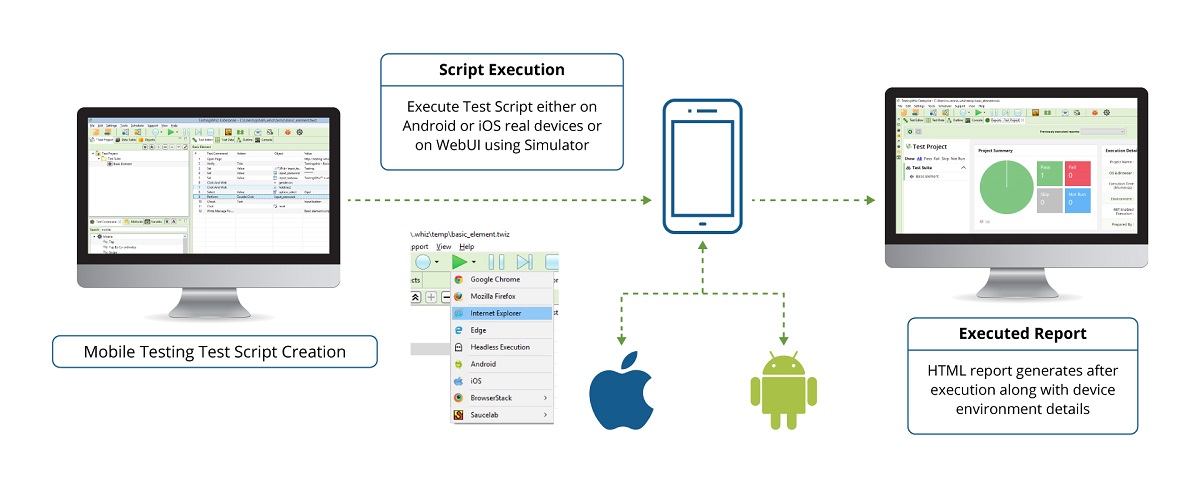Selecting an enterprise resource planning (ERP) system is, of course, just the first step of the process. There are many important processes you need to take care of, such as management, communications, training, and testing. Testing in particular is a key to a smooth implementation.
What are the basics of ERP testing?
To conduct ERP testing you’d normally start with writing up a script for a usual kind of transaction. To make sure no issues occur, go through with a transaction and see if the outcome is what you anticipated.
The first step of the testing should be a simple transaction, such as receiving an order or writing a check. Then you can start with more complex transactions. For example, you can examine your receipt with an incoming quality check and move it to inventory. The final round of testing is often referred to as “order to cash” – a complex chain of transactions that involves various features and departments and can last a few days.
Make sure you conduct the test in supervised laboratory-style conditions. The tests might get pretty monotonous, so switching a few things up here and there might be beneficial.

Automated Testing Solution During ERP Implementation
Automated testing solutions ensure the perfect conditions as well as provide you the appropriate controls for your ERP testing. The tests won’t last that long, which means you can get more testing done in the same period of time. Besides, it is quite affordable too. That leaves your staff at the conference room to do other work while cutting down the costs of testing.
Tests are there to determine the viability of your chosen ERP If a problem occurs, you need to carefully analyze what led to it. Was there a mistake in the script? Did you make a configuration switch that made it all go awry? Or maybe the data from a legacy system didn’t translate the way it was meant to? Finding out the cause of an error can be quite tricky, so it’s important to conduct thorough testing in various departments to make sure it doesn’t happen again.
Besides conducting quick and consistent testing, some systems will also help you find the root of the problem and suggest a way to correct it. If a test you ran and marked green already turns out to be the cause of downstream failure, the color will automatically change to yellow.
You might say that before the automated testing systems came around, people have successfully installed ERP systems by themselves. And while it’s true, they are a great aid to make sure your implementation will go as planned.
Of course, automated testing is not free, but neither is the work of the people who can do it manually, so choose the option that works best for you. One thing is certain: the accuracy and thoroughness automated testing ensures are great for any business. If you do the testing manually, a new problem might occur at any time, no matter how many tests you’ve run before.

Why automated testing?
Enterprise Resource Planning (ERP) seems to have a bright future ahead of it. It easily takes care of the businesses’ needs in promotion, assembling, and other processes. Since it applies different routine search processes, it helps create a secure and precise information archive as well.
The collected information is then put away by ERP frameworks which ensure the optimal item arranging and business procedures. Besides, ERP frameworks are made to adapt to any future changes in your business. To successfully implement an ERP solution, make sure to constantly test the frameworks and resolve any issues that might occur.
When you implement new software, it is important to conduct ERP testing to make sure that everything runs smoothly. The testing should consider your business’s specific needs and ensure every feature works exactly as it should.
Your ERP usage process is crucial for your business, so testing is a great way to know that it won’t let you down. There are many ways ERP testing can be conducted. In this article, we will describe different testing techniques, which can help you get the most out of your system.
Testing methods

When implementing a new ERP solution, consider these testing techniques to make sure your system implementation runs smoothly with the least amount of risk.
- Functional Testing. At this stage, testing helps you find out if your ERP framework provides you with the arrangements for all your particular needs. It checks whether all your programming and equipment meets your expectations. Thus, summarizing your testing objectives and destinations can go about as a gauge to determine the success of functional testing.
- Performance Testing. This method verifies the ERP’s capacity to run individual tasks in their particular environments. Considering the ERP runs multiple coordinated frameworks, make sure to test it in the most common circumstances, including those with high information streams and transactions.
- Automated Testing. This testing strategy deals with the automation of processes and makes difficult monotonous tasks easier by completing them simultaneously. Therefore, choosing the right automation tool that includes all test forms, is a very important step of the testing procedure.
- Integration testing. This type of testing applies the system to your common business situations. The testing helps you find out whether your system integrates well enough with your organization’s procedures and processes.
Why does testing need to be automated for enterprise resource planning solutions?
Since ERP frameworks can be very complex, their testing might be quite bothersome. Some surveys show that testing can take up to half of the total ERP budget. Manual testing doesn’t ensure the optimal functioning of your ERP, so opting for automated testing can guarantee your testing is fast and affordable.
Here are some arguments in favor of automated testing:
- Greater efficiency and output. They have a big amount of data and don’t demand as much time, money and assets as manual testing
- Flexibility. They get can be adapted to your unique industrial requirements and occasionally any standard framework is executed.
- Synchronization to frameworks. They are complex and carefully synchronized with various frameworks. The yield of one module can contribute to another, and manual testing can make it even more difficult
- Greater integration. Systems are intertwined in different areas and are carefully adjust to local requirements
- Up-to-date. They are constantly updated to accommodate evolving systems, while inaccessibility of master manual testing assets can lead to frequent delays in your ERP schedule
Top 10 Benefits of Automated Testing
Test automation is a great way to optimize your mobile app testing, but many companies don’t know how to incorporate it into their development process. However, automated testing can help you create an error-free app in a shorter amount of time, so it is definitely something worth considering.
In its core, automated testing is using a machine to do work that used to be done by humans. The machine, unlike humans, can work around the clock with fewer mistakes and better speed.
Now that’s not a new concept, is it? Of course, it’s not. Think about the industrial revolution, when the assembly line was introduced. If the work is monotonous and repetitive, humans usually lose concentration and may miss some errors or problems. Machines, on the other hand, are built to do this kind of work in a fast and precise manner.
The industrial revolution responded to a need to produce identical parts that would be compatible with each other so that the assembly process becomes faster and production is more efficient.
If history isn’t enough to convince you, keep reading to find out 10 reasons how automated testing can help your business.
ROI
The initial investment is something that might scare you off. However, it is proven that such an investment will save you time and bring long-term ROI improvement for your business.
Around-the-clock testing
Clearly, automated testing doesn’t require nearly as much supervision as manual testing. The test can run at night when you’re not in the office or even remotely if you don’t have many devices.
Human Resources
Automated testing only requires one person – test automation engineer, who will write the scripts for your testing. This way, you don’t have to anyone to do time-consuming manual testing.
Reusability
The scripts for automated testing can be used multiple times. The test will keep being exactly the same even if the version of the OS on the device is different.
Bug Fixing
Automated testing can find bugs in the very first stages of software development and thus prevent any major setbacks and the expenses they create.
Dependability
Automation is the most reliable and fastest way to run repetitive tests. Manual testing runs the risk of human error, especially when the work starts getting boring.
Efficiency on multiple devices
You can use the exact same scripts to run tests on multiple devices at the same time, which can give you comparative detailed reports in a short amount of time.
Continuity
Automated testing can be of great help to automation engineers. Through reports, they get a chance to see what tests have already been conducted, what scripts have been written, and what problems have occurred.
Additional methods
A stress test is a great example of an additional method of testing that cannot be done manually. Stress test works the application and operational infrastructure to the limits and tests it in such extreme conditions.
Greater testing volume
Automation allows you the testing on more than 18 thousand devices at the same time. Such scope would be unachievable through manual testing. So with automated testing, you can get high-quality software with fewer problems in a shorter amount of time and less human resources.
The Cons of Automated Testing
To give you the whole picture, here are some disadvantages of automated testing that you should be aware of.
- Automated testing isn’t meant to resolve every customer problem. The scripts include the most common simple operations, such as logging into the app or creating an account and makes sure they run smoothly. Individual problems aren’t something automated testing can deal with.
- App crashes in individual cases must be tested manually. The machines can do many things, but not everything, at least not yet.
- Automated testing can’t be used to test the effectiveness of user experience design – are the buttons positioned well, is the app easy to use, etc. You can only do it through manual user-friendly testing.
Conclusion
Overall, there are clear pros and cons of both manual and automated testing. Therefore, the wisest option would be combining automated and manual testing. Automated testing works best for simple repetitive cases, while manual testing is great for complex individual cases and can help you optimize your app’s user experience.
A normal ERP condition includes many automated business forms that can get very time consuming with manual testing. Automated testing ensures that the ERP meets all the established requirements of your business. Furthermore,Test automation provides you with consistent testing that helps you recognize any emerging problems so that you can be protected from a major setback.
As ERP application modules are connected to a centralized data storage, updating test automation guarantees a flawless running of your business’s critical processes as well as allow you to observe how information flows across your organization.
Tested ERP applications guarantee you’re giving your stakeholders precise high-quality reactions. Test automation ensures you deliver everything promptly and don’t get delayed by tedious manual testing. This way you optimize the routine procedures in terms of time and cost, which leads to enhanced income and an improved ROI.
In the end, choosing the testing method is just as important as choosing the ERP software solution itself.
If your company is planning to implement an ERP solution, it is important to partner with companies that can help you implement it as seamlessly as possible drawing from a pool of experienced and time-tested specialists. And, in doing so, ensure that your ERP solution is appropriate for your unique business requirements. The right partner will help you formulate a strategy from start to finish, and see it through – so that you get the most bang for your buck.